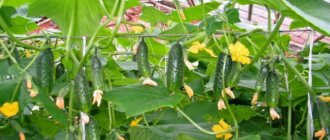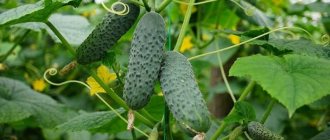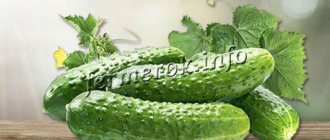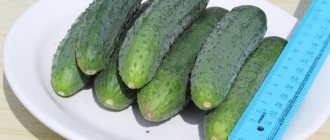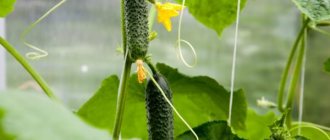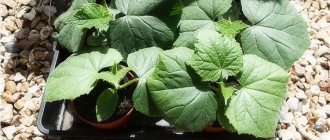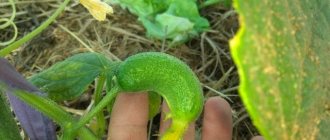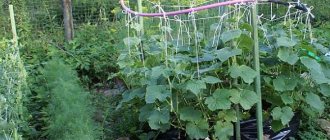For its excellent taste in fresh and salted form, Ginga F1 has won the love of many farmers. The cultivar belongs to a hybrid line of German selection. Among the bonuses of the hybrid are resistance to cucumber pathogens, stable productivity, resistance to heat and bad weather.
| Landing location | Ripening time | Mode of application | Fruit length | Group | Fruit smoothness | Pollination method |
| Universal | Early ripening (35-45 days) | Universal | Short (gherkins) - less than 10 cm | Hybrid | Highly lumpy | Parthenocarpic |
Description of the variety
Ginga F1 cucumbers (the designation “F1” indicates a hybrid origin from two different varieties) are mid-season cultivated plants of German selection. The hybrid is universal, intended for open ground and growing in controlled conditions. The variety has been zoned for cultivation in the Central Black Earth region, as well as in adjacent territories.
The plant is a parthenocarpic long-climbing bush with numerous ovaries. It is medium-sized, forms small leaves of rich green color. The shape of the leaves is heart-shaped, five-lobed. The stem is often creeping, with a rough surface, about 1-2 m high, ending in tendrils.
Agricultural technology
Ginga F1 cucumber is planted with seeds directly into the ground. It is recommended to allocate well-lit areas for cucumber beds. First, dig up the soil and add organic fertilizers to it. Immediately before planting cucumbers, the beds are watered with warm water.
Cultivation does not imply the use of special technologies. When growing a hybrid, a number of rules are followed:
- There is no need for preliminary germination of seed material.
- There is no need to thicken cucumber plantings. Sowing of seeds is carried out according to a pattern of 30 x 70 cm with the obligatory deepening of them to a depth of 4 cm.
- Timely pinching of side shoots. The shoots are removed from the main shoot until the fifth leaf appears on it. If cucumbers are grown in a greenhouse, then gardeners recommend pinching the main shoot and not letting the side shoots go beyond the second leaf.
- Correct watering regime. During hot periods, the plant needs frequent moisture. When the night air temperature drops below 15°C, it is recommended to stop abundant watering.
- Timely application of nutrients. Vegetable growers recommend using nitrogen-containing, potassium, and phosphate fertilizers.
- Providing warmth. When growing crops in open ground, you need to monitor the temperature. Cucumbers are adapted to temperatures from 19°C to 35°C. The difference between day and night thermometer readings should not be more than 5 points. To provide the plant with the necessary heat, use a film cover.
Advice from vegetable growers
Tips to help increase productivity
Cucumber beds need to be weeded frequently: this provides oxygen access to the root system of the crop and also helps to destroy weeds.
Vegetable growers who want to get a harvest of gherkins no larger than 7 cm in size collect cucumbers every 2 days.
Gardeners who dream of getting a harvest in large volumes and at an earlier date should grow the hybrid variety Ginga in seedlings.
Fruit characteristics
The fruits are cylindrical in shape, rounded at the edges. They grow small, up to 10–15 cm in length with a width of about 3-4 cm; They are distinguished by smooth skin with a slightly ribbed surface. A slight white pubescence often forms on top of the peel. The color of the fruit is predominantly dark green, with short white stripes developing on top of the main color.
The yield of the variety is quite high and is in the range of 5-6 kg per m2. The average weight of a cucumber is 80-90 g. The taste of the fruit is high; The harvest is distinguished by juicy, elastic and crispy pulp. The yield of marketable products is at least 88%.
Harvested cucumbers are versatile; they are ideal for fresh consumption, as well as for preparing all kinds of dishes, including canned food.
Advantages and disadvantages
- The main advantages of the variety:
- increased productivity;
- female type flowering;
- resistance to powdery mildew and olive spot;
- early harvest dates;
- versatility of fruits;
- good yield of commercial products.
- No serious deficiencies were identified in the variety, with the exception of the need for specific agricultural cultivation techniques and the formation of bushes. In addition, the high cost of seed material is often considered a disadvantage.
Agricultural technology of sowing and growing
The Ginga F1 hybrid is loved by vegetable growers due to its versatility and unpretentiousness - the plant can be successfully cultivated both in open ground and in protected conditions (greenhouse). However, in each individual case this requires compliance with special technology and growing rules.
In the open ground
In open ground, cucumbers are often grown in seedlings, otherwise the plants will not have time to fully develop and produce an abundance of fruit. Cultivation of cucumbers in open ground begins with growing seedlings. They begin sowing seeds in the second half of April. For this, both individual small containers and common trays are used, and the depth of the containers should be at least 8–10 cm - this helps to avoid diving into a new container, which often leads to the death of a third of the seedlings.
Did you know? The history of cucumber cultivation goes back about 6
thousand years.
The plant’s homeland is considered to be the southern regions of India and the foothills of the Himalayas, where it is still found in wild form today. Sow seeds only in nutritious and loose soil; any fertile substrate from flower shops is suitable for this. As an alternative, you can use a mixture of equal parts of peat, turf soil and vermiculite (can be replaced with perlite or river sand). For 10 liters of such substrate you need to add 1-2 tbsp. l. nitrophoska and 2 tbsp. l. wood ash.
Before sowing, the soil is sterilized; to do this, you can choose to soak it with 2% potassium permanganate, fry it in the oven (at +125°C, about 30 minutes) or keep it in the freezer for 2-3 days (at -25°C). After this, the substrate is kept at room temperature for about a week, and only then does it become suitable for sowing.
Seeds also require preparation for sowing. First, they should be sterilized: the procedure is carried out by soaking in specialized solutions, which can be 70% alcohol (up to 10 minutes), 2% potassium permanganate (20–30 minutes) or a solution of the drug “Fitosporin” (10–20 minutes). Next, the seeds need to be activated - to do this, they are wrapped in a damp cloth and kept for 2 days at a temperature of about +20°C. Then they are moved to the refrigerator, where they are stored for about a day, after which they are directly sown.
The seeds are sown in rows - rows or small holes about 4 cm deep are created in the planting container, and the distance between them should be about 6 cm. The crops are loosely covered with soil, after which they are well soaked with water.
In the future, cucumbers are provided with standard care:
- temperature +22…+26°С;
- regular watering - the soil should not dry out, so water the crops every 4 days;
- loosening the soil to a depth of 3-4 cm;
- daylight for at least 12 hours (crops need additional lighting).
Did you know? In ancient times, cucumber was one of the most popular vegetable crops. It is even mentioned in the Bible as a traditional vegetable of Ancient Egypt.
After the seedlings have lengthened to 15–20 cm, and at least 4-5 leaves have formed on the plants, the seedlings can be transplanted into open soil. This period usually occurs 20–25 days after sowing the seeds. In this case, the average daily air temperature should become no less than +15°C. In temperate climate zones, this period often begins in the middle or second half of May. Plants are planted according to a 40x50 pattern (holes - rows), with a passage at least 80 cm wide created every 2 rows on the site.
In the greenhouse
Growing cucumbers in a greenhouse is one of the most common methods of creating optimal conditions for the crop on the site. This is especially important for northern regions, with short and cold summers.
Sowing begins with preparing the soil in the greenhouse. To do this, all pollutants are removed from it, as well as remnants of vegetation, dug well to a depth of 30 cm, and then watered with a 2-3% solution of copper sulfate or Bordeaux mixture.
As soon as the soil dries, you should divide the area for sowing. Plants are sown in rows, so parallel furrows are cut on the soil with an inter-furrow space of 40 cm and a depth of 10 cm. Every 2 rows, an 80 cm inter-row passage is created (for easy care of the plantings). Immediately before sowing, the rows should be well fertilized: to do this, they are half filled with fresh manure, then covered with a 2-3 cm layer of soil and watered well. Before sowing, the seeds are also prepared - this is done in the same way as in the case of growing seedlings.
After excess moisture is absorbed into the soil, the seeds are sown. Sowing is done so that the seeds in the row are located at a distance of 20 cm from each other. To do this, additional depressions (about 10 cm) are created in each row, in each of which at least 2 seeds are placed. This is required in order to avoid low germination of the seed.
To ensure that the seeds germinate as quickly as possible, the beds are provided with moderate moisture and a stable air temperature. As soon as several leaves appear on the young shoots, the beds are thinned out. After the procedure, no more than one, the most developed and active plant, should remain at one growth point. Otherwise, plants rooted nearby will compete for soil space and nutrients (possibly causing low yields).
As soon as young cucumbers form 4-5 leaves, they can be transferred to standard care.
Important! If you use stationary greenhouses and grow cucumbers in a monoculture, then every 3-5 times you must change the soil (top layer 30 cm). This will protect the beds from low yields and pest invasions.
Landing Features
Ginga f1 cucumbers can be grown not only in open soil, but also in closed soil: in a greenhouse or greenhouse. It is not recommended to grow this variety of cucumbers on the balcony, since the cucumber bushes reach large sizes.
For early harvesting, cucumbers are planted in seedlings. However, direct sowing is possible: sowing seeds in open soil.
Landing dates
Sowing of seeds of the Ginga cucumber variety is carried out, as a rule, in the second half of April - early May. The main thing is that the temperature of the earth reaches 15 degrees Celsius.
Site preparation
To prepare a plot of land, agronomists recommend mixing peat with turf ash and vermiculite (or river sand) in equal proportions. In addition, before sowing Ginga f1 cucumbers, the soil must be sterilized using one of the methods described below:
- Treat planting material with manganese;
- Keep the seeds in the oven at 125 degrees for 30 minutes;
- Place the seeds in the freezer for 2 or 3 days.
After such treatment of the land, it is recommended to wrap the area in film so that the temperature of the earth becomes room temperature.
Planting seeds
Before planting cucumber seeds, they need to be prepared for sowing. To do this, the seeds are placed in a manganese solution for 30 minutes, and then placed in a damp cloth for 48 hours. After planting, the soil should be thoroughly watered with water at room temperature.
Planting seedlings
To obtain seedlings, cucumber seeds must be placed in a 4 cm container and watered well at room temperature. To further maintain the seedlings, it is necessary to provide them with systematic watering (once every 4 days), loosening the soil, additional lighting, and also maintain the air temperature (22-26 degrees Celsius).
After the sprouts have reached a height of 20 cm and 5 leaves have formed on them, the bushes are transplanted into open soil. As a rule, this process is carried out 25-30 days after sowing the seeds. However, do not forget that the air temperature should not be below 15 degrees Celsius.
Planting scheme
It is recommended to plant cucumber seeds in holes 3-4 cm deep. The distance between rows should be about 6-10 cm.
When planting seedlings of Ginga cucumbers, the bed size is 40x50, that is, the distance between holes is 40 cm, and between rows is 50 cm.
After every second row, it is necessary to leave a small passage (up to 1 m) to make it convenient to harvest.
Features of care
Regardless of the growing method, Ginga F1 cucumbers require standard growing conditions. They include soil care, timely fertilizers and regular watering. In this case, special attention should be paid to the formation of the bush, without which it will not be easy to achieve increased yield and early ripening of fruits.
Watering and fertilizing
The cucumber fruit consists of 90–95% water, so if there is a lack of moisture in the soil, the plant will not be distinguished by high and high-quality yields. Irrigation must be carried out regularly. At first, young plants are watered moderately, only after the soil has dried slightly - this is a mandatory requirement, since waterlogging the soil will lead to rotting of the root system. However, it is not recommended to water the beds less than once every 5 days.
More regular watering begins after the young bushes produce at least 7–10 leaves. From this point, until the end of the growing season, the soil should be provided with moderate moisture with minimal fluctuations in soil moisture. Otherwise, the plant will form small and bitter fruits. Depending on the air temperature, this will require at least 2-3 procedures per week. But during drought, irrigation is done daily.
The first feeding of cucumbers is done in the 7-leaf phase. If the vegetable is grown by seedlings, the favorable time for this comes 2 weeks after planting the seedlings in open soil. The first fertilizing should contain a high nitrogen content, so solutions of cow manure (1:10) or chicken manure (1:15) are used for this, with a flow rate of about 5 l/m².
The second time the beds are fertilized after the plantings begin to bloom. At this time, cucumbers need a liquid mineral mixture; it is prepared from 40 g of superphosphate, 30 g of ammonium nitrate and 20 g of potassium nitrate (per 10 liters of water). The resulting solution is used for root irrigation; the calculation of the working fluid should be about 5–8 l/m².
During the fruiting period, cucumbers need increased levels of potassium and phosphorus in the soil . To compensate for the deficiency of these elements, superphosphate (2 tablespoons per 10 liters of water) and potassium nitrate (20–30 g per 10 liters of water) are used, with a working fluid flow rate of 5 l/m². Such fertilizing can be done every 10 days, while fertilizers are alternated, which helps create better conditions for the crop.
Important! Fertilizing is done only in dry weather. If there is a rainy period at the time of fertilization, then crushed wood ash is used for fertilization at the rate of 1 cup/m² of plantings.
Garter and bush formation
Cucumbers are tied up after about 7 leaves have formed on the bush. To do this, an individual peg made of metal or wood, about 1.5 m high, is installed near each plant, at a distance of 10 cm from the bush. As an alternative, you can use a common trellis - it is a rod fixed at a height of 2 m above the beds. It is supported by 2 horizontal posts fixed to the edges of the bed. Plants are attached to the trellis using strong twine, which is tied with one edge to the rod and the other to a small peg installed near the plant.
Cucumbers also need high-quality formation. They do this as follows:
- in the area of the first 2-3 leaves of the root zone, all lateral growth points are removed;
- in the middle of the stem, in the area of every 3-4 nodes, the growing points are removed, leaving 2 leaves and 2 fruiting shoots;
- No more than 3 fruiting shoots are left at the top of the bush. If necessary, the top is thinned out, leaving no more than 3-4 leaves on the plant.
Soil care
Caring for the soil in cucumber plantings is a mandatory measure, which allows you to create the necessary soil microclimate, as well as protect the bushes from all kinds of pests. Weeding and loosening are often combined, doing the procedure at least once a week, to a depth of 10 cm. At the same time, the remains of weeds and their root system must be removed from the beds.
The best time for loosening and weeding is considered to be 2-3 days after watering, which helps to avoid drying out of the substrate. But they can also be carried out the next day after irrigation. The best period for caring for the soil is considered to be early morning, but loosening can also be done in the evening.
After weeding and loosening the beds need to be mulched. The procedure makes it possible to protect plants from drying out, as well as create the necessary temperature regime in the soil. To do this, a near-trunk circle with a diameter of 30 cm is created around the trunk of each bush, which is densely covered with the covering material, a layer of 5–10 cm.
The following can serve as mulch:
- sawdust;
- conifer bark;
- spruce and pine needles;
- humus;
- expanded clay;
- special artificial materials (agrofibre, geotextiles, etc.).
How to grow a hybrid yourself
Ginga f1 is adapted for cultivation in open ground and in greenhouses. To obtain an earlier harvest, the seedling method is used. It is possible to sow seeds directly into open ground.
The choice of planting option is always up to the gardener, but, regardless of the method, growing a hybrid brings excellent results.
Planting by seeds and seedlings
In open ground, cucumbers are grown mainly through seedlings. This helps to achieve higher yields than when sowing directly into the ground. Seeds are planted at the end of April. For planting, you can use cups with a depth of at least 10 cm or common boxes. Sowing in a separate container will avoid picking, which has a bad effect on young plants.
Sow seeds in loose soil. Ready-made mixtures for growing flowers are well suited. When preparing the soil yourself, mix peat, turf soil and vermiculite in equal proportions. The last ingredient can be replaced with river sand. Nitrophoska and wood ash are added to this substrate.
Before sowing, the soil should be sterilized. There are three ways to do this:
- Soak with potassium permanganate solution.
- Heat in the oven for half an hour at a temperature of no more than +125 °C.
- Keep for 2-3 days in the freezer at temperatures down to -25 °C.
After sterilization, the soil must be kept for a week, maintaining room temperature.
You will also need to prepare the seeds for sowing. They are disinfected in a solution of potassium permanganate for half an hour, then kept at a temperature of +20 ° C in a damp cloth for 48 hours.
Cucumbers are sown in furrows up to 4 cm deep, maintaining a distance of 6 cm between rows. The seeds are sprinkled with soil and watered well.
In the process of growing seedlings, you should ensure:
- maintaining ambient temperature +22–26 °C;
- watering every four days;
- loosening the soil;
- additional lighting.
After the seedlings reach a height of 15–20 cm and form 4-5 leaves, the plant is planted in open ground. This usually happens 25 days after sowing the seeds.
Important! Please note that the ambient temperature should not be less than +15 °C.
When planting cucumbers in the garden, they adhere to the 40x50 pattern (holes-rows). Passages approximately one meter wide are left every two rows.
Growing and care
Hybrid Ginga does not require special growing conditions. The plant needs watering, timely fertilization of the soil and garter.
Water the cucumbers regularly, at least once a week. Do not allow the soil to become waterlogged - this can lead to rotting of the roots and death of the bush.
When 10 leaves are formed on the plant, you can start watering more frequently, 2-3 times a week. The soil should be constantly moderately moist. If this condition is not met, the fruits may become bitter. During dry days, cucumbers are watered daily.
Fertilizers begin to be applied when at least seven leaves are formed on the plant. The first feeding should have a high nitrogen content. To do this, use a solution of cow manure or chicken droppings. The second time, fertilizers are applied at the time of flowering: a mineral mixture is prepared from superphosphate, ammonium nitrate and potassium nitrate. The solution is used for root watering.
It is also necessary to feed the hybrid with potassium and phosphorus at the time of fruiting. Superphosphate is best suited for this purpose. Fertilizing is done every 10 days, always in dry weather.
Cucumbers need to be tied when 7 leaves appear. A peg is installed near the plant or each bush is attached with twine to a common rod at a height of 2 m.
Features of cultivation and possible difficulties
Particular attention is paid to the formation of the bush. Without this, it will be difficult to obtain high yields; the fruits will take longer to ripen.
Formation is carried out in the following way:
- near the first two sheets, the lateral growth points are removed;
- in the middle of the stem, the growing points in the zone of 3-4 nodes are removed and two leaves and two shoots are left;
- No more than three shoots are left at the top of the bush. If necessary, thin out the top of the plant.
Resistance to diseases and pests
When breeding a hybrid, the breeders had a goal to achieve resistance to diseases and pests. Ginga f1 has strong immunity to diseases characteristic of cucumbers . However, if the plant is not properly cared for, there is a possibility that fusarium will develop in the garden bed.
Of all known pests, aphids can attack crops. It is important to quickly respond to the appearance of a disease or insects and take measures to preserve the plant.
Disease and pest control
Although the Ginga F1 cucumber is classified as a plant that is resistant to characteristic diseases and pests, if agricultural practices for care and cultivation are not followed, the beds become infected quite often. The fight against diseases and pests should be started immediately, since in just 1-2 weeks they can completely destroy the plantings.
The most common cucumber infections are:
| Name | Ways to fight |
| Anthracnose | Affected beds are treated with copper oxychloride, at a rate of 40 g per 10 liters of water. |
| Bacteriosis | Infected plants are treated with solutions of copper oxychloride, with a concentration of 40 g per 10 liters of water |
| Downy mildew | When a disease appears, cucumbers should be optionally sprayed with solutions of the preparations “Acrobat MC” 69%, “Ridomil MC” 72%, “Kurzat R” |
Typical crop pests:
| Name | Ways to fight |
| Thrips | The beds are sprayed with the preparation "Actellik", "Confidor" 20% or "Karate" |
| Ticks | The plantings are treated with a solution of “Aktellika” 50% or “Talstar” 10% |
| Aphid | Treatment with the insecticide “Confidor” 20% or “Karate” will help you cope best. |
| Cucumber bugs | Solutions “Confidor” 20%, “Karate” will help eliminate the pest |
Pests and diseases
Breeders from Germany tried to ensure that the hybrid variety Ginga was resistant to various diseases and pests.
Diseases
The variety is not susceptible to classic diseases of cucumber bushes. If improperly cared for, fusarium will develop in the beds.
Vegetable growers recommend carrying out preventive soil treatment. For this purpose, special fungicides are used.
Pests
Insects that can harm crops include aphids. These small parasites can establish colonies on Ginga cucumber bushes. Control methods involve treating the plant with solutions prepared according to folk recipes or based on special preparations.
Harvest and storage
The first harvest of Ginga F1 ripens on average on the 45th day after the first shoots, by this time the fruits will have acquired a length of 10 cm. Cucumbers are harvested every 2-3 days, but at the height of fruiting, the fruits are removed from the garden every day. The harvest is harvested using a sharp knife, which is used to separate the stalk from the bush.
The collected fruits are thoroughly cleaned of soil residues and other contaminants, and then washed under running water. Clean cucumbers are dried naturally and then transferred to the refrigerator. The most optimal temperature for storing the crop is considered to be +5°C, which allows you to keep cucumbers fresh for 2-3 weeks. For longer storage, the fruits are pickled.
Important! Fruits are washed only with cold water, at a temperature no higher than +20°C. Warm and hot water will damage the cucumber tissue, which significantly reduces the shelf life of the crop and its marketability.
Ginga F1 is an excellent example of highly skilled selection of fruit crops . The plant is adapted for fruiting in almost any climate, and is characterized by high yield and quality of fruit. This makes it possible to effectively use the hybrid for both home and industrial vegetable growing, including as a raw material for canning and other processing.

